การวิเคราะห์และพัฒนาองค์ประกอบการท่องเที่ยวถวิลหาอดีตต่อความตั้งใจกลับมา ท่องเที่ยวประเทศไทยของชาวไทยไกลบ้าน
Main Article Content
บทคัดย่อ
การศึกษาครั้งนี้มีวัตถุประสงค์ เพื่อวิเคราะห์และพัฒนาองค์ประกอบการท่องเที่ยวถวิลหาอดีตต่อความตั้งใจกลับมาเที่ยวประเทศไทยของนักท่องเที่ยวชาวไทยไกลบ้าน เป็นการวิจัยเชิงสำรวจและพัฒนา เก็บรวบรวมข้อมูลเชิงปริมาณ จากการแจกแบบสอบถามแบบเจาะจงและบอกต่อกับกลุ่มประชากรไทยที่อาศัยอยู่ในต่างประเทศจำนวน 400 คน วิเคราะห์ข้อมูลด้วยการวิเคราะห์องค์ประกอบเชิงสำรวจ (Exploratory Factor Analysis: EFA) เพื่อค้นหาตัวแปรแฝง และการวิเคราะห์องค์ประกอบเชิงยืนยัน (Confirmatory Factor Analysis: CFA) เพื่อพัฒนาองค์ประกอบที่มีนัยสำคัญ ผลการศึกษาพบว่า องค์ประกอบเชิงสำรวจ (EFA) และองค์ประกอบเชิงยืนยัน (CFA) ของการท่องเที่ยวถวิลหาอดีต สามารถแบ่งออกได้ 3 ด้าน ได้แก่ การขัดเกลาทางสังคม อัตลักษณ์ความเป็นชาติ และอัตลักษณ์บุคคล โดยสามารถอธิบายความแปรปรวนได้ร้อยละ 67.91 เมื่อพัฒนาด้วยองค์ประกอบเชิงยืนยัน พบว่า โมเดลองค์ประกอบมีความกลมกลืนกับข้อมูลเชิงประจักษ์ คือ Chi-square = 5119.798, df = 2.4, GFI = .963, AGFI = .930, NFI = .966, IFI = .977 CFI = .977 และ RMR = .019 ผลการวิจัยชี้ให้เห็นว่า องค์ประกอบการท่องเที่ยวถวิลหาอดีตสามารถจำแนกการถวิลหาอดีตของนักท่องเที่ยวชาวไทยไกลบ้านที่มีต่อประเทศไทย ซึ่งหน่วยงานหรือผู้ที่เกี่ยวข้องสามารถนำข้อมูลนี้ไปใช้หรือพัฒนากลยุทธ์ทางการท่องเที่ยว สร้างจุดเด่นเพื่อดึงดูดให้นักท่องเที่ยวเกิดการระลึกถึงและปรารถนาจะกลับมาท่องเที่ยวซ้ำในอนาคต
Article Details
บทความที่ได้รับการตีพิมพ์เป็นลิขสิทธิ์ของวารสารมนุษยศาสตร์และสังคมศาสตร์ มหาวิทยาลัยอุบลราชธานี
ข้อความที่ปรากฏในบทความแต่ละเรื่องในวารสารวิชาการเล่มนี้เป็นความคิดเห็นส่วนตัวของผู้เขียนแต่ละท่านไม่เกี่ยวข้องกับมหาวิทยาลัยอุบลราชธานี และคณาจารย์ท่านอื่นๆในมหาวิทยาลัยฯ แต่อย่างใด ความรับผิดชอบองค์ประกอบทั้งหมดของบทความแต่ละเรื่องเป็นของผู้เขียนแต่ละท่าน หากมีความผิดพลาดใดๆ ผู้เขียนแต่ละท่านจะรับผิดชอบบทความของตนเองแต่ผู้เดียว
เอกสารอ้างอิง
ปาริฉัตร แทนบุญ. (2561). บ้าน ความทรงจำสีฟ้า. วิทยานิพนธ์ปริญญามหาบัณฑิต, มหาวิทยาลัยศิลปากร.
สำนักงานปลัดกระทรวงการท่องเที่ยวและกีฬา. (2562, กันยายน). สถิติจำนวนและรายได้นักท่องเที่ยวต่างชาติ. สืบค้นเมื่อ 28 เมษายน 2564, จาก https://www.mots.go.th/News-link.php?nid=13174
รุ้งนภา ยรรยงเกษมสุข. (2555). การโหยหาอดีต: ความเป็นอดีตในสังคมสมัยใหม่. วารสารการเมือง การบริหาร และกฎหมาย. 4(2), 59-89.
“Away from home.” Merriam-Webster.com Dictionary. Retrieved on 3 February 2021, from https://www.merriam-webster.com/dictionary/away%20from%20home.
Baker, S.M. & Kennedy, P.F. (1994). Death by nostalgia: A diagnosis of context-specific cases, In C.T. Allen & D.R. John (Eds.), Advances in consumer research (Vol.21, pp. 169-174). Provo, UT: Association for Consumer Research.
Bowlby, J. (1979). The making and breaking of affectional bonds. London: Tavistock.
Chandralal, L. & Valenzuela, F. (2013). Exploring memorable tourism experiences: Antecedents and behavioural outcomes. Journal of Economics, Business and Management, 177-181.
Cho, H., Lee, H.W., Moore, D., Norman, W.C. & Ramshaw, G. (2017). A multilevel approach to scale development in sport tourist nostalgia. Journal of Travel Research, 56(8), 1094-1106.
Gao, J., Lin, S. S., & Zhang, C. (2020). Authenticity, involvement, and nostalgia: Understanding visitor satisfaction with an adaptive reuse heritage site in urban China. Journal of Destination Marketing & Management, 15, 100404.
Hair, J.F., Black, W.C., Bain, B.J., Anderson, R.E. & Tatham, R.L. (2006). Multivariate data Analysis (6th ed.). Upper Saddle River, NJ: Pearson Education International.
Io, M.U. & Wan, P.Y.K. (2018). Relationships between tourism experiences and place attachment in the context of Casino Resorts, Journal of Quality Assurance in Hospitality & Tourism. 19(1), 45-65.
Jarratt, D. & Gammon, S. (2016). We had the most wonderful times: Seaside nostalgia at a British resort. Tourism Recreation Research, 41, 123-133.
Jorgensen, B.S. & Stedman, R.C. (2006). A comparative analysis of predictors of sense of place dimensions: Attachment to, dependence on, and identification with lakeshore properties. Journal of Environmental Management, 79(3), 316-327.
Kim, J., Ritchie, J.R.B. & Tung, W.S.V. (2010). The effect of memorable experience on behavioral intentions in tourism: A structural equation modeling approach. Tourism Analysis, 15, 637-648.
Kim, S. & Kim, S. (2018) Segmentation of potential film tourists by film nostalgia and preferred film tourism program, Journal of Travel & Tourism Marketing, 35(3), 285-305.
Krejcie, R. V. & Morgan, D. W. (1970). Determining Sample Size for Research Activities. Educational and Psychological Measurement, 30(3), 607-610.
Leong, A., Chang, Y.L. (2015). Nostalgic tourism in Macau: The bidirectional causal relationship between destination image and experiential value. Journal of Hospitality and Tourism Technology, 6(1), 89-99.
Loureiro, S.M.C. (2014). The role of the rural tourism experience economy in place attachment and behavioral intentions. International Journal of Hospitality Management, 40, 1–9.
Mackie, D. M., Devos, T., and Smith, E. R. (2000). Intergroup emotions: explaining offensive action tendencies in an intergroup context. J. Pers. Soc. Psychol. 79, 602–616.
McKercher, B. (2002). Towards a classification of cultural tourists. International Journal of Tourism Research, 4(1), 29-38.
Niezgada, A. (2013). Prosumers in the tourism market: the characteristics and determinants of their behaviour. Poznan University of Economics Review, 13(4), 130-141.
Park, S., Hwang, D., Lee, W. S., & Heo, J. (2020). Influence of nostalgia on authenticity, satisfaction, and revisit intention: The case of Jidong mural alley in Korea. International Journal of Hospitality & Tourism Administration, 21(4), 440-455.
Sedikides, C., Wildschut, T., Routledge, C., Arndt, J., Hepper, E. G., & Zhou, X. (2015). Chapter five – To nostalgize: Mixing memory with affect and desire. Advances in Experimental Social Psychology, 51, 189–273.
Silberberg, T. (1995). Cultural tourism and business opportunities for museum and heritage places. Tourism Management, 16(5), 361-365.
Smeekes, A., & Jetten, J. (2016). Longing for one’s home country: National nostalgia and acculturation among immigrants and natives. Utrecht, The Netherlands: Utrecht University, Ercomer.
Stern, B. (1992). Historical and personal nostalgia in advertising text: The fin de siècle effect. Journal of Advertising, 21(4), 11-22.
Tajfel, H. (1981). Human groups and social categories: Studies in social psychology. Cambridge University Press, Cambridge: UK.
Uriely, N. (2005). The tourist experience: Conceptual developments. Annals of Tourism Research, 32(1), 199-216.
Vada, S., Prentice, C & Hsiao, A. (2019). The influence of tourism experience and well-being on place attachment. Journal of Retailing and Consumer Services, 47©, 322-330.
Wildschut, T., Bruder, M., Robertson, S., van Tilburg, W. A. P., and Sedikides, C. (2014). Collective nostalgia: a group-level emotion that confers unique benefits on the group. J. Pers. Soc. Psychol. 107, 844–863.
Williams, Patterson, M.E., Roggenbuck, J.W. & Watson, A.E. (1992). Beyond the commodity metaphor: Examining emotional and symbolic attachment to place. Leisure Science, 14(1), 29-46.
Yoon, Y. & Uysal, M. (2005). An examination of the effects of motivation and satisfaction on destination loyalty: A structural model. Tourism Management, 26(1), p. 45-56.
Yuksel, A. Yuksel, F. & Bilim, Y. (2010). Destination attachment: Effects on customer satisfaction and cognitive, affective and conative loyalty. Tourism Management, 31(2), 274-284.
Zhou, G., Liu, Y., Chen, W., & Yang, Q. (2020). Relationship between Triggers of Nostalgia and Revisit Intention in Rural Tourism. Revista Argentina de Clínica Psicológica, 29(1), 536.


